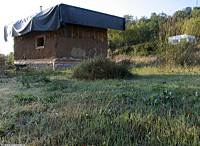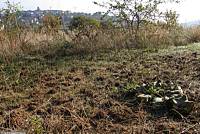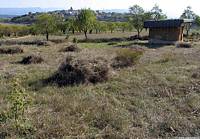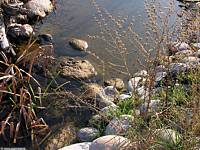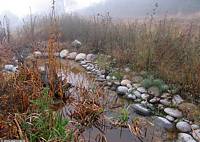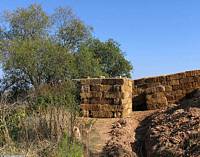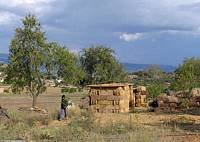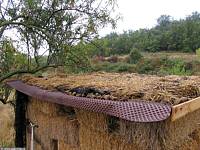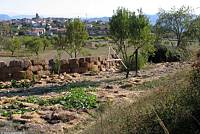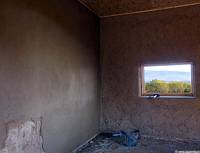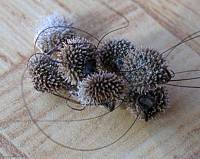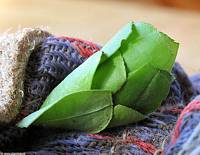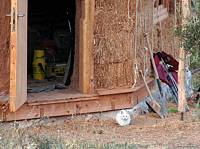|
|
Nature
Switched On
|
|
|
introduction |
2009 September 18 to 25 In the middle of the month there
was a substantial amount of rainfall (about 35 litres) which put an
end to a long hot summer. Temperatures almost don't reach 25ºC
anymore and vegetation and wildlife start to resurrect literally
from the ground.
We are very busy these days with the infrastructure
of surface pipes and plastering but I was able to squeeze out time
for some hay making. The cutting of the vegetation will offer a nice
green carpet a
|
The annual grass Bromus diandrus is massively
germinating on the |
|
The earthworms have woken up from their summer retreat. Looking east. 24 Sep 9:43 |
||
|
Haymaking around the garden
house. The green campsite patch at the back was cut in July. Looking east. 25 Sep 10:05 |
||
|
The rain filled the ponds for 50%. The upper pond had completely
dried out and the water fill readily provoked the appearance of
mosquito larvae. This is another reason
|
||
| Dry
stalks of Mentha pulegium. New shoots are appearing. 24 Sep 9:38 |
Dry and new leaves of Lythrum salicaria (left)
and Sparganium erectum (centre). |
|
|
Less enthusiastic am I about the garden wall made of straw bales.
They are not protected from the rain and were also mounted with gaps
(to avoid lee side turbulence) but they have started to fall in and
over and offer a poor sight. This will only get worse in coming
years and I don't think I will have the patience to wait for the
vines to cover and grow over this heap of tumbled bales. I will take
these walls away and think of alternatives.
|
||
|
'Transformer-station' and sound barrier. The barrier wall reduces the noise and smell of the neighbouring dogs. Looking south-east. 24 Sep16:39 |
||
| The very
similar compost toilet housing is a bit larger and features an
experimental green roof. Looking east. 20 Sep 16:40 |
||
| The green
roof of the compost toilet has withstood satisfactorily the35-litre
rainstorm. 18 Sep 9:49 |
The straw bale garden wall is
already showing its shortcomings. 22 Sep 10:25 |
|
|
The optimum mix for the plaster seemed to be in fact 25% clay soil and 75% sand and I applied a layer on an interior wall. When drying there still appeared quite some cracks but this, I read, is inevitable and can be more or less retouched with a sponge. Nevertheless, I will paint this final layer with lime wash, which, among multiple advantages, will dissimulate the remaining irregularities and offer more light inside. |
||
|
The finish plaster layer on the left. About 200 litres (450kg) of
plaster on 10m2. 24 Sep 9:24 |
||
|
In the curiosity cabinet of wildlife shelters I can add another original design. This time made by a kind of wasp (?) who had fixed its shelter on one of my working gloves. It was making a hell of a noise and at first I was bewildered because I heard a constant sound of a wasp around me but couldn't see anything flying. The shelter was made by gluing wild rose leaves together to form a small tube of about 2cms. Also curious is this procession of entangled hedgehogs. They aren't of course: the individuals are seeds of Cynoglossum creticum and the hairs are Blanca's. When jumping the service pipe trench, Blanca fell over and touched with her head for a fraction of a second this plant with its ripe seed and she had her hair instantaneously covered with them. It took us almost half an hour to take about 25 seeds out of her hair.
|
||
|
Rose leaf shelter on one of my gloves. 21 Sep16:16 |
Blanca's hairs entangled in some
seeds of Cynoglossum creticum. 21 Sep16:18 |
|
|
Every evening, around 7 o'clock we receive a visit from a beautiful white stray cat. It comes of course for its daily portion of cat food we offer, but we make sure not to give too much so that there will be enough hunger left to go after the mice. |
||
|
The white guard posting at the
entrance of the garden house. 23 Sep 20:04 |
||
|
introduction
|
|
